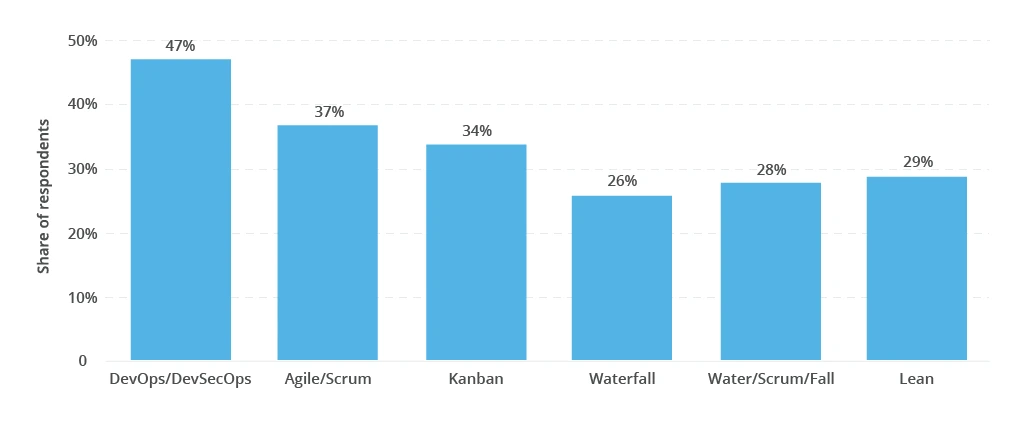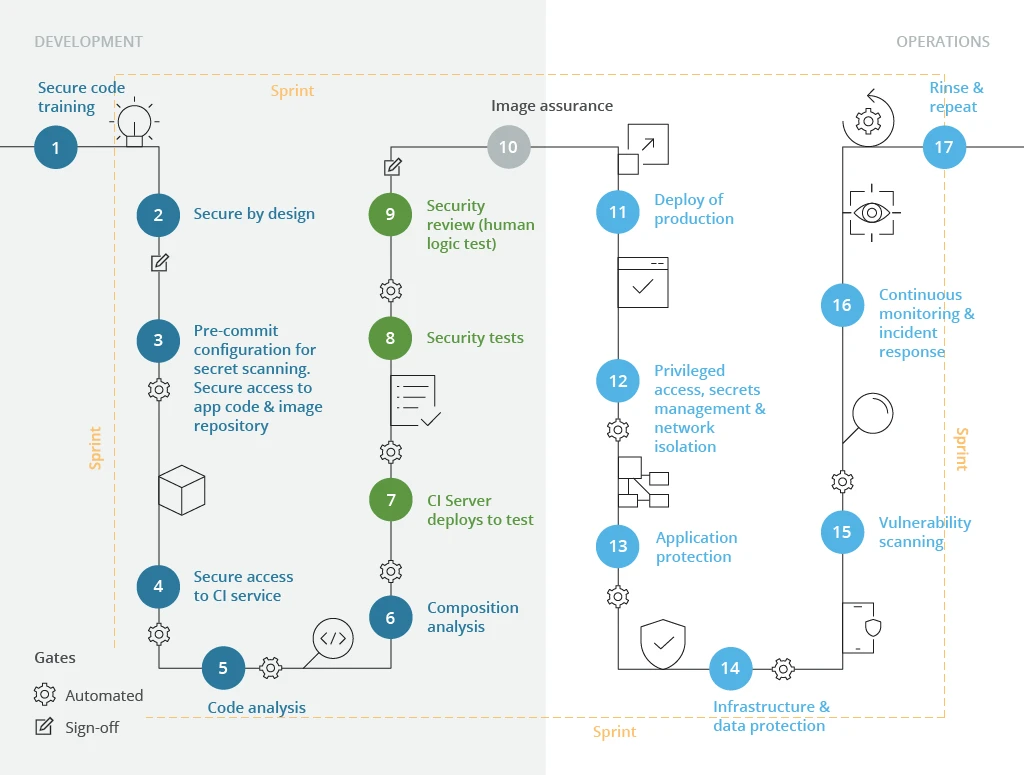7 Challenges for Establishing an Efficient DevOps Process
DevOps is the leading software development methodology used by 47% of developers worldwide. The value of the global DevOps market was $10.9 billion in 2023, and by 2032, it will reach $63.4 billion at a CAGR of 21%.
With the growing demand for accelerating software product development, transferring legacy systems to the cloud, and embracing innovations, nearly 84% of respondents admit they face barriers in DevOps adoption.
In this article, we will review the key DevOps challenges and solutions to build efficient and reliable DevOps processes.
Why Is DevOps a Never-Aging Development Approach?
The major factors that allow DevOps to excel over other development approaches include:
- Shifting from traditional data centres to hybrid systems
- Focus on automation
- Increasing growth of microservices architectures
- Demand for fast software delivery and heightened operational competence.
These drivers, together with the extending capabilities and potential of the DevOps approach make it rank high across all the leading industries:
There are also other benefits that compensate for DevOps challenges and explain such stable market growth for years already:
- DevOps promotes more effective collaboration between development, operations, and security teams by informing them of each other’s progress, needs, objectives, and streamlining communication between departments.
- Modern DevOps platforms help reduce labor costs through the automation of testing, deployment, and infrastructure management processes.
- Companies can take new products to market faster: continuous integration and continuous deployment (CI/CD) enables developers to release product updates more frequently, while automation testing and deployment pipelines reduce manual work, speed up pushing code changes to production.
- DevOps helps enhance quality and reliability across the development process by automated testing as a part of the CI/CD pipeline. It helps eliminate risks associated with complex software releases, get fewer emergency fixes, and increase customer satisfaction as a result.
- It gives organizations greater control over managing their software product lifecycle through robust monitoring and feedback mechanisms. Gaining insights from how the code performs in production helps address issues, optimize product performance proactively, and iterate on the software more efficiently.
Find out more about the value and benefits of DevOps approach for business in a related article.
What Challenges in DevOps Adoption Have Businesses to Confront?
Despite the tangible advantages, switching to DevOps requires time, investments, and expertise. The challenges created by the adoption of DevOps may disrupt the workflows and lead to security flaws and compliance issues if not handled adequately. Here are tried and tested ways from Infopulse experts how they address such issues effectively.
1. Switching from Legacy Infrastructure to Microservices
Switching to microservice infrastructure leads to managing a big number of service components deployed independently. It complicates tracking dependencies, fix issues, and maintain the correct functioning of the entire system.
Solution: You should adopt tools and practices for effective management and monitoring of your microservices environment, including:
- CI/CD pipelines to automate build, test, and deployment processes (Jenkins, GitLab CI, CircleCI)
- Containerized microservices (Docker) to maintain consistency across development, testing, and production environments
- Orchestrating containerized microservices (Kubernetes) to automate load balancing, service discovery, and scaling management.
2. Integration Complexity
Integrating different tools, systems, resources, and even specialists into a DevOps pipeline may be complicated. Using a mix of proprietary tools and open-source solutions can lead to compatibility issues and more complex pipeline management.
Solution: The following practices help address the integration challenges caused by the adoption of DevOps:
- Standardize Toolchains: choose a consistent set of tools for CI/CD, infrastructure management, and monitoring.
- Automate processes: implement CI/CD pipelines and user Infrastructure as Code (IaC).
- Use integrated platforms: Choose an end-to-end DevOps platform like GitLab or cloud-based DevOps services like Azure DevOps. For example, Infopulse has significantly increased the development and delivery speed by deploying CI/CD DevOps practices and IaC when developing an innovative IoT solution for offline space management.
- Strengthen collaboration: Create cross-functional teams and encourage open communication between departments to align efforts across the entire team.
3. Resistance to Change
In big organizations, people often find it comfortable to work in legacy systems and do not support any changes in technologies and tools. It may be challenging to adopt DevOps when team members resist training and changing their habitual routines.
Solution: You can easily combat resistance to changes by clearly communicating the benefits of adopting new practices and support the shift with appropriate training and onboarding support. In general, focus on:
- Clarifying your objectives: articulate the vision and goals of adopting a DevOps approach and explain the improvements to workflows, efficiency, effort optimization, and overall value you expect from such a huge shift.
- Education and training: continuously provide training sessions, workshops, certifications to help your team develop the necessary skills to comfortably adapt to a new way of working. For instance, in the project for Zeppelin, which involved significant modernization of sales management platform, our team performed a 5-day workshop for knowledge transfer helping the client’s team to adapt to changes.
- Gradual implementation: adopt DevOps practices in phases, starting with pilot projects, and expand based on feedback and observed benefits.
4. Lack of Cross-Functional Teams
Efficient DevOps adoption implies cross-functional teams where specialists can collaborate effectively on all the stages of the development process. However, establishing such teams requires specialists with diverse skills and expertise.
Solution: You can fulfill the missing skills and collaborative culture in the team by:
- Encouraging collaboration between departments and specialists. For this, establish shared goals and align them with your organization’s vision and objectives.
- Adopting communication tools like Slack, Microsoft Teams, Jira, etc. to communicate and coordinate work among the team members.
- Providing training for developing the missing skills through workshops, seminars, and other training programs relevant to your organization’s needs
- Implementing shared metrics like key performance indicators (KPIs) that show the entire team’s progress, not only individual performance to cultivate the collective sense of achievement.
5. Selecting the Right DevOps Metrics
The diversity of metrics and monitoring tools available in DevOps makes it challenging to focus on tracking the most relevant metrics to measure the efficiency and performance of the processes for a specific organization. Monitoring all the data may not be informative enough to recognize necessary re-adjustments. Moreover, it will take a lot of time and effort to process all the available parameters.
Solution: Focus on metrics aligning with your business goals to get meaningful insights about the efficiency of DevOps processes. In its final value, there are three primary project success criteria, including customer satisfaction, fitting the initial project time and budget. From our practice, we consider a project successful if its duration is not 15% longer than the initial estimation, and the initial budget is changed only upon the client’s requirements, with no extra expenses behind them. Explore the software development metrics that help assess overall productivity.
6. Security in DevOps
Security can be a large area of concern because developers often use programs, libraries, frameworks, and software development kits (SDKs) developed by outside vendors. Third-party code may contain security vulnerabilities that may lead to compromising your software entirely. On the other hand, security on the client’s side may also be a problem beyond the control of the development services vendor.
Solution: DevSecOps approach helps address DevOps security challenges by integrating security mechanisms into the DevOps processes from the start. Strengthening collaboration between the security, operations, and development teams helps deploy continuous security monitoring with detecting threats proactively. Adopt DevSecOps tools and processes from the early stages of the development cycle.
7. Choosing and Adopting the Right DevOps Tools
The DevOps market offers numerous tools to choose from. The choice of DevOps toolchain for a specific organization defines the overall adoption success and cost-efficiency. Relying on the market leaders does not guarantee this success, as every organization has unique processes of the software development lifecycle, different team structures and needs.
Solution: Choose the optimum DevOps toolset based on the needs and goals of your organization. Evaluate the compatibility of the selected systems with your infrastructure and other systems they will integrate with. Keep in mind your needs for scalability and future expandability to adjust to future changes.
Again, before purchasing the complete set of licenses, start with the pilot implementation with shortlisted tools to evaluate how they perform in your environment. Always ask for feedback from your team to assess the effectiveness of the selected toolchain.
Check our guide to assess your organization’s maturity and performance before DevOps transition.
Key Takeaways
Being the leading software methodology, DevOps continues to rank the highest among other development approaches due to its benefits in optimizing the development process, faster time-to-market, and lower operational costs through automation. However, there are certain DevOps challenges in the adoption journey which require actionable measures.
At Infopulse, we help organizations tackle the complexities of DevOps adoption and achieve a more cost-efficient and better-performing development environment. Besides technological support and tailored solutions under our DevOps services, we provide knowledge transfer workshops and training to onboard teams to the new toolchain and processes, ensuring a smoother transition to the DevOps approach.
![DevOps Adoption Challenges [banner]](https://www.infopulse.com/uploads/media/banner-1920x528-7-devops-challenges-for-efficient-adoption.webp)





![Cloud-Native for Banking [thumbnail]](/uploads/media/cloud-native-solutions-for-banking_280x222.webp)
![Generative AI and Power BI [thumbnail]](/uploads/media/thumbnail-280x222-generative-AI-and-Power-BI-a-powerful.webp)
![Cloud Native vs. Cloud Agnostic [thumbnail]](/uploads/media/thumbnail-280x222-cloud-agnostic-vs-cloud-native-architecture-which-approach-to-choose.webp)
![Azure Monitor for SAP [thumbnail]](/uploads/media/thumbnail-280x222-azure-monitor-for-sap-solutions-an-overview.webp)

![Mortgages Module Flexcube [Thumbnail]](/uploads/media/thumbnail-280x222-Secrets-of-setting-up-a-mortgage-module-in-Oracle-FlexCube.webp)
![Digital Alignment Drivers [thumbnail]](/uploads/media/thumbnail-280x222-the-top-forces-driving-digital-alignment.webp)
![AWS vs. Azure Cloud Platform [Thumbnail]](/uploads/media/thumbnail-280x222-comparison-of-aws-vs-azure-when-each-cloud-platform-works-best.webp)
![Cloud-Native Maturity Model Assessment [thumbnail]](/uploads/media/thumbnail-280x222-what-Is-the-cloud-native-maturity-model-definition-and-assessment-criteria.webp)
![Containers vs VMs for Microservices [thumbnail]](/uploads/media/thumbnail-280x222-containers-vs-vms-what’s-better-for-microservices.webp)